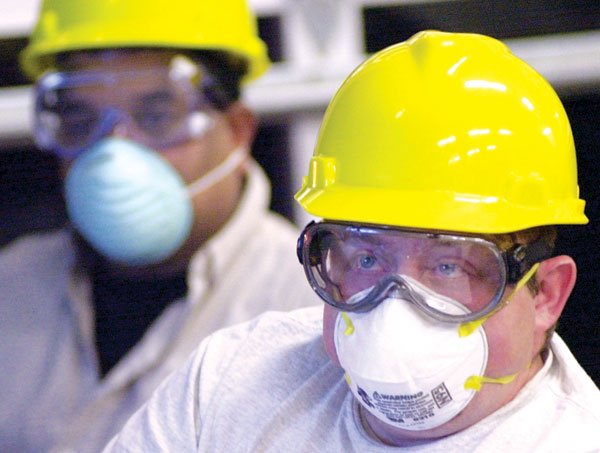GILROY
– One woman is lying on the ground while two other women are
taping her arm to her body. A man sits in a chair as a cardboard
splint is applied to his leg. This is a hands-on practice session
of the Gilroy Community Emergency Response Team, an eight-week
program that teaches residents the fundame
ntals of first aid.
GILROY – One woman is lying on the ground while two other women are taping her arm to her body. A man sits in a chair as a cardboard splint is applied to his leg. This is a hands-on practice session of the Gilroy Community Emergency Response Team, an eight-week program that teaches residents the fundamentals of first aid.
The program was developed to create a well-trained civilian emergency work force. These teams are vital during disaster situations when the number and scope of incidents overwhelm conventional emergency services. The training provides community self-sufficiency through the development of response teams that can act as an adjunct to local emergency services during major disasters.
Gilroy is a rural area, and in the event of a local disaster resources could be heavily taxed.
“CERT is about readiness, people helping people and doing the greatest good for the greatest number,” said Paul Staudenmaier, chairman of the South County Neighborhood Disaster Preparedness Project, which collaborated with Gilroy Fire Department and the city to run the program. ”It’s a positive and realistic approach to emergency and disaster situations where citizens will be initially on their own and their actions can make a difference. Through training, citizens can organize themselves to be effective.”
During a recent exercise at the Chestnut Fire Station, participants practiced diagnosing and treating an airway obstruction, bleeding and shock by using simple triage and rapid treatment techniques, and they learned how to evaluate patients by doing a head-to-toe assessment, establishing a medical treatment area, and performing basic first aid.
CERT was started by the Los Angeles City Fire Department in 1985 in response to the area’s vulnerability to earthquakes and fires. The Federal Emergency Management Agency (FEMA), the Emergency Management Institute (EMI) and the National Fire Academy have adopted the CERT program.
“Following a major disaster, first responders who provide fire and medical services will not be able to meet the demand for these services. People will have to rely on each other for help in order to meet their immediate life-saving and life-sustaining needs,” Staudenmaier said. “We also expect that under these kinds of conditions, family members, fellow employees, and neighbors will spontaneously try to help each other. This was the case following the Mexico City earthquake where untrained, spontaneous volunteers saved 800 people. However, 100 people lost their lives while attempting to save others. This is a high price to pay and is preventable through training.”
The program is new to Gilroy.
”We will weigh its overall effectiveness, costs involved, and whether the community wants a program like this to continue,” said Geoff Cady, the local program coordinator.
Residents believe the program will prove beneficial.
“I believe in being prepared,” said Burdetta Moore, who lives in Woodland Mobile Home Estates. “We have elderly and housebound residents at Woodlands, I want to be ready to help and know what to do.”
Joe Lomeli was living in Sherman Oaks, a suburb of Los Angeles, when the Northridge Earthquake struck.
“I’ve seen what happens without training,” he said. “It was total chaos. I live in Eagle Ridge, and I’m concerned about accessibility in times of an emergency. I’ve learned that quick response is imperative. I’m learning how to be self sufficient for a week or more by being prepared. ”
For 24-yar-old Eric Ingrassia this program is a refresher course. He took the program with his mother a year ago in Morgan Hill.
“Initially I wanted to learn what to do in a disaster and how to help save the lives of others,” he said. “I came back to get updated on new information, I was interested in the information that is included this time on response during an act of terrorism.”
The eight sessions cover disaster preparedness, fire suppression, disaster medical operations, light search and rescue operations, disaster psychology and team organization, course review and disaster simulation. The Gilroy class has about 25 participants ranging from teenagers to senior citizens.
The program costs $25. For more information, call the Chestnut Fire Station at
846-0370.















